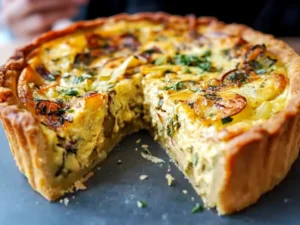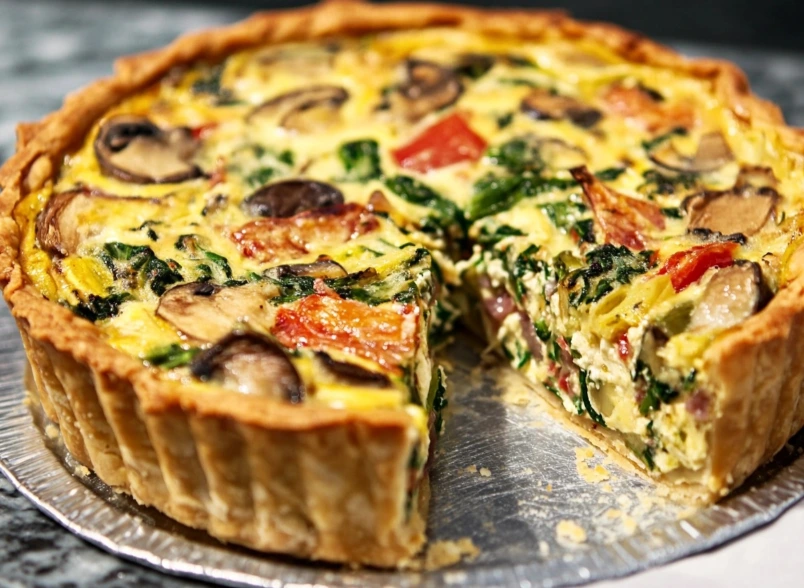The Ultimate Vegetable Quiche Recipe Guide
Overview of Vegetable Quiche Recipe
A vegetable quiche is a delicious and versatile dish that combines the richness of eggs, cream, and cheese with a medley of fresh vegetables, all baked to perfection in a flaky pie crust. It is a popular choice for breakfast, brunch, or even a light dinner, cherished for its ability to blend a variety of flavors and textures into one delightful dish. Whether served warm or at room temperature, vegetable quiche is a culinary staple that never fails to impress.
What Is a Vegetable Quiche?
Definition, History, and Culinary Significance
Definition
A vegetable quiche is a savory custard pie made with a mixture of eggs, milk or cream, and various vegetables, often accompanied by cheese and seasonings. It is encased in a buttery pastry crust, which provides a satisfying crunch that contrasts beautifully with the creamy filling. Common vegetable inclusions are spinach, mushrooms, onions, zucchini, bell peppers, and tomatoes, but the recipe can be easily tailored to individual tastes and dietary preferences.
History
Vegetable quiche recipe originated in Germany, with its roots tracing back to the medieval kingdom of Lothringen, now Lorraine, France. The word “quiche” is derived from the German word “kuchen,” meaning cake. The original quiche, Quiche Lorraine, traditionally featured a filling of eggs, cream, and bacon. Over time, the dish evolved to include a variety of ingredients, eventually becoming a global favorite. The vegetable quiche variation emerged as a healthier, vegetarian-friendly alternative, showcasing the adaptability of this timeless recipe.
Culinary Significance
Vegetable quiche recipe holds a prominent place in the culinary world due to its simplicity, versatility, and ability to highlight seasonal produce. It is an excellent way to incorporate a variety of vegetables into a meal, making it a nutritious choice for families, food enthusiasts, and even professional chefs. Its adaptability to accommodate different dietary restrictions, such as gluten-free or dairy-free options, further underscores its universal appeal. Additionally, vegetable quiche is a staple in catering menus and gatherings, beloved for its ability to be prepared ahead of time and served in slices, making it both practical and delicious.
Ingredients for the Perfect Vegetable Quiche
Crafting the perfect Vegetable quiche recipe starts with selecting high-quality, fresh ingredients. From vibrant vegetables to creamy dairy and fragrant herbs, every component plays a vital role in creating a harmonious balance of flavors and textures. This section explores the essential ingredients and their variations, ensuring a quiche that satisfies every palate.
Fresh Vegetables to Include
Seasonal Options and Nutritional Value
Fresh vegetables are the heart of a vegetable quiche, adding flavor, texture, and color. Choosing seasonal produce ensures peak freshness and optimal taste. Here are some popular options:
- Spinach: A classic choice for its earthy flavor and high iron content.
- Mushrooms: Adds a rich umami flavor and a meaty texture.
- Zucchini: Provides a mild, slightly sweet taste, and pairs well with stronger flavors.
- Bell Peppers: Adds sweetness and a vibrant color palette.
- Tomatoes: Juicy and tangy, perfect for a burst of freshness.
- Broccoli: Offers a satisfying crunch and is a great source of vitamins C and K.
- Asparagus: A springtime favorite, known for its delicate flavor.
Cheese Choices for Quiche
Best Types and Vegan Alternatives
Cheese is integral to a quiche’s creamy and indulgent filling. Different cheeses can dramatically alter the flavor profile. Here are the top choices:
- Gruyère: A classic choice, known for its nutty and slightly sweet taste.
- Cheddar: Sharp and tangy, it adds a robust flavor.
- Feta: Salty and crumbly, ideal for Mediterranean-inspired quiches.
- Goat Cheese: Creamy and tangy, perfect for a gourmet twist.
- Parmesan: Adds a rich, umami depth when used in moderation.
For vegan alternatives:
- Nutritional Yeast: Imparts a cheesy flavor without dairy.
- Vegan Shredded Cheese: Plant-based options made from cashews, almonds, or soy, mimicking the texture and melt of traditional cheese.
- Tofu or Cashew Cream: Blended with seasonings, these can replace cheese for a smooth and creamy filling.
Crust Options for a Vegetable Quiche
Traditional, Gluten-Free, and Shortcut Variations
The crust serves as the foundation for a quiche, providing a delightful crunch that contrasts with the creamy filling. Here are some crust options:
- Traditional Pastry Crust: Made with flour, butter, and water, it is flaky and rich. A go-to for most quiche recipes.
- Gluten-Free Crust: Often made with almond flour, rice flour, or a combination of gluten-free flours to cater to dietary restrictions.
- Shortcut Variations:
- Phyllo Dough: Adds a light and crispy texture.
- Store-Bought Pie Crust: A convenient option for busy cooks.
- No-Crust Quiche: For a low-carb alternative, skip the crust altogether and pour the filling directly into a greased pie dish.
Here is the revised text with more transition words for better flow and simpler word choices for improved readability:
Essential Tools and Equipment
To make a vegetable quiche with ease, you need a few important kitchen tools. These will help you create a perfect crust, cook the filling evenly, and present the dish beautifully:
- Pie Dish: A 9-inch pie dish works best. Glass or ceramic dishes are great for even baking and easy monitoring.
- Rolling Pin: This tool is important for rolling the crust to just the right thickness.
- Mixing Bowls: You will need bowls of different sizes for preparing the crust, mixing the eggs, and tossing the vegetables.
- Whisk: Use this to mix eggs, cream, and spices into a smooth mixture.
- Sharp Knife and Cutting Board: These are needed to chop vegetables neatly.
- Sauté Pan or Skillet: A skillet allows you to pre-cook vegetables to enhance their flavor and avoid extra moisture in the quiche.
- Parchment Paper and Pie Weights: These are used for blind baking the crust, which keeps it from puffing up.
- Grater: If you use block cheese, a grater is a must for shredding it easily.
- Measuring Cups and Spoons: These tools ensure you measure everything accurately.

Step-by-Step Instructions for Making Vegetable Quiche Recipe
Preparing the Crust
Rolling, Pre-Baking, and Tips
- Mix the Dough: First, combine flour, cold butter, and water to form a dough. Be careful not to overmix, as this keeps it flaky.
- Chill: Next, wrap the dough in plastic wrap and chill it for at least 30 minutes. This step makes the dough easier to handle.
- Roll Out: Roll the dough on a floured surface into a circle slightly larger than your pie dish. Then, transfer it carefully to the dish and trim the edges.
- Blind Bake:
- Start by placing parchment paper over the crust and filling it with pie weights or dried beans.
- Bake at 375°F (190°C) for 10–15 minutes, or until slightly golden.
- Afterward, remove the weights and bake for another 5 minutes. Let it cool before adding the filling.
- Tips:
- Always use cold butter to achieve a flaky crust.
- Avoid stretching the dough, as this can cause it to shrink during baking.
Prepping Vegetables for the Filling
Washing, Chopping, and Sautéing
- Wash and Dry: Before starting, rinse all vegetables thoroughly under cold water. Then, pat them dry to remove extra moisture.
- Chop Evenly: Cut vegetables into even sizes to ensure they cook consistently.
- Sauté:
- Begin by heating a little oil or butter in a skillet.
- Add vegetables in stages, starting with those that take longer to cook, such as onions or mushrooms.
- Cook them until tender and slightly caramelized, but avoid overcooking.
- Finally, season the vegetables with salt, pepper, or herbs to enhance their flavor.
- Cool Down: Allow the cooked vegetables to cool slightly. This step is important to prevent the custard from curdling.
Assembling and Baking
Layering Ingredients, Baking Time, and Temperature
- Layer the Filling:
- First, sprinkle a thin layer of cheese over the crust. This helps prevent moisture from seeping into the crust.
- Next, spread the sautéed vegetables evenly across the crust.
- Finally, add another layer of cheese or herbs to boost the flavor.
- Prepare the Custard:
- In a bowl, whisk together eggs, cream (or milk), salt, and pepper until the mixture is smooth.
- Carefully pour the custard over the vegetables, making sure it fills all the gaps without spilling over.
- Bake:
- Preheat your oven to 375°F (190°C).
- Place the quiche on the middle rack and bake for 35–45 minutes. You’ll know it’s ready when the filling is set and golden brown.
- To check, insert a knife into the center; it should come out clean.
- Cool and Serve:
- Let the quiche cool for about 10–15 minutes before slicing. This allows the filling to set properly.
- Serve it warm, at room temperature, or even chilled.
Tips for Perfecting Your Vegetable Quiche Recipe
Creating a flawless vegetable quiche requires attention to detail and some practical strategies. Below are tips to address common challenges and elevate your quiche to perfection.
Avoiding Soggy Crust
Key Techniques to Master
- Blind Bake the Crust: Pre-baking the crust is crucial to keep it crisp. Use parchment paper and pie weights to prevent puffing during the initial bake.
- Seal with Cheese: Before adding the filling, sprinkle a layer of shredded cheese over the crust. When melted, it acts as a barrier, preventing moisture from seeping into the crust.
- Drain and Dry Vegetables: Vegetables release water as they cook. Sauté them thoroughly to remove excess moisture before adding them to the filling. For especially watery vegetables like zucchini or tomatoes, pat them dry with a paper towel after slicing.
- Thicker Custard: Avoid overly thin custard by ensuring a good balance of eggs and cream. The standard ratio is one large egg for every ½ cup of cream or milk.
- Bake on the Lower Rack: Positioning the quiche on the lower oven rack helps the crust cook evenly and become crisp.
Balancing Flavors
Ensuring Every Bite Is Flavorful
- Season in Layers: Season the vegetables while cooking, the custard while whisking, and the entire assembled quiche before baking. This ensures the flavors are consistent throughout.
- Choose the Right Cheese: Select cheeses that complement your vegetables. For example, pair spinach with feta or mushrooms with Gruyère. A mix of mild and sharp cheeses can add complexity.
- Incorporate Fresh Herbs: Herbs like thyme, parsley, or chives add freshness and aroma. Sprinkle them into the custard or as a garnish before serving.
- Avoid Overloading with Ingredients: While it’s tempting to include many vegetables and cheeses, too much can make the filling heavy and overpower other flavors. Use 2–3 vegetables and one or two cheeses for balance.
- Taste Before Assembling: Taste individual components like the sautéed vegetables or custard mixture to adjust seasoning before putting the quiche together.

Frequently Asked Questions
To help you perfect your vegetable quiche and address any concerns, here are answers to common queries about storage, preparation, and key differences in cooking techniques.
Can I Freeze a Vegetable Quiche?
Storage and Reheating Tips
Yes, vegetable quiche freezes well and can be enjoyed later without compromising much on quality. Here’s how:
- Freezing:
- Allow the quiche to cool completely after baking.
- Wrap it tightly in plastic wrap or aluminum foil, or place it in an airtight container.
- Freeze for up to 2–3 months.
- Reheating:
- Thaw the quiche in the refrigerator overnight.
- Reheat in a preheated oven at 350°F (175°C) for 20–25 minutes until heated through. Avoid using the microwave, as it may make the crust soggy.
How Long Does Quiche Stay Fresh?
Shelf Life and Safety
Properly stored quiche can remain fresh and safe to eat for a few days:
- Refrigerator: Store the quiche in an airtight container or tightly wrap it. It stays fresh for up to 3–4 days.
- Freezer: As mentioned, frozen quiche lasts 2–3 months. Ensure proper wrapping to prevent freezer burn.
- Always check for any signs of spoilage, such as an off smell or discoloration, before consuming.
What’s the Best Pan for Quiche?
Bakeware Recommendations
The right pan ensures even cooking and easy serving. Here are the top choices:
- Pie Dish: A 9-inch glass or ceramic pie dish is traditional and allows even heat distribution.
- Tart Pan: A tart pan with a removable bottom is excellent for easy slicing and presentation, especially for quiches with decorative edges.
- Metal Pan: A metal tart or quiche pan can create crispier crusts due to its excellent heat conductivity.
Choose a pan with at least a 1.5-inch depth to hold the filling securely.
Should You Cook Vegetables Before Putting Them in Quiche?
Yes, cooking vegetables before adding them to the quiche is highly recommended. This step removes excess moisture, enhances flavor, and ensures the vegetables are tender. Sautéing or roasting vegetables also caramelizes them slightly, adding depth to the dish.
What Is the Secret to a Good Quiche?
The key to a great quiche lies in its balance:
- Custard Ratio: Use the correct egg-to-liquid ratio (1 egg to ½ cup of cream or milk) for a creamy, not rubbery, texture.
- Seasoning: Layer seasoning at each step for full-bodied flavor.
- Pre-Baking: Blind-bake the crust to keep it crisp and avoid sogginess.
- Vegetables: Pre-cook vegetables to enhance their flavor and avoid adding extra water to the filling.
Is Heavy Cream or Milk Better for Quiche?
Both heavy cream and milk can be used, but they yield different results:
- Heavy Cream: Produces a rich, custard-like filling with a velvety texture.
- Milk: Results in a lighter quiche with a slightly firmer filling.
- Combination: A mix of both (e.g., ½ cup cream and ½ cup milk) balances richness and lightness, offering the best of both worlds.
What Is the Main Difference Between a Quiche and a Frittata?
While quiche and frittata share similarities, they differ in key ways:
- Crust:
- Quiche: Has a buttery crust that holds the filling.
- Frittata: Crustless, cooked directly in a skillet or ovenproof pan.
- Custard Ratio:
- Quiche: Contains a higher amount of cream or milk, creating a softer texture.
- Frittata: Has less or no liquid, resulting in a firmer texture.
- Cooking Method:
- Quiche: Baked in the oven.
- Frittata: Cooked on the stovetop and often finished in the oven or under the broiler.

